


 |
October 25, 2018: Bandelier National Monument and Valle Grande |
 |
October 23, 2018: Tent Rocks and Ghost Ranch |
 |
Return to the Index for Our Trip to New Mexico |
Today, we are going to start off by driving a short distance to the historic area of Chimayo, New Mexico, to visit two historic churches there. Then, after a stop at the Chimayo Museum, a weaving shop, and an art gallery, we will drive up to Ojo Caliente to sit in the hot springs and do some hiking.
Historic Chimayo
The first item on today's agenda will be a visit to the historic area of Chimayo, where there are number of churches, chapels, and old residences.
|
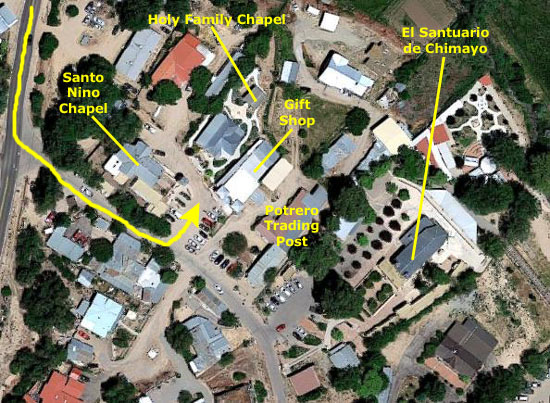
We turned off the highway on the street that leads into the historic district and, as it turned out, we found a parking place right in front of the Santo Nino Chapel. Then we walked around the historic area, visiting the spots that I marked on the aerial view of this area above, right.
Santo Nino Chapel
|
|
The stories that are attached to this chapel make seeing it an experience in and of itself! The history of the Santo Nino Chapel can be traced back to the country of Spain during the 1400s. It was during this time period that many Christian men had been imprisoned and starved in their cells. Only children were allowed to visit the prisoners and bring food to them. The wives, sisters, and daughters of these men prayed for help, and it soon arrived in the form of a small boy.
This child visited the prisoners regularly and brought them food. According to legend, his basket was never empty of bread and his water gourd was always full. He soon became considered as the manifestation of Jesus Christ himself and earned the nickname "Santo Nino", or "Holy Child". Over the years, the Santo Nino would become a celebrity-like figure in the religious community. A statue of Our Lady of Atocha holding the Holy Child in her arms was created for a church in Plateros, Mexico. The Santo Nino would often be removed to bring healing and help to women giving birth and spread miracles to the sick and poor.
|
In a small prayer room adjacent to the main chapel is the small wooden statue of the Santo Nino. The sculpture depicts the Holy Child holding his water gourd and a basket of bread. (Photography was banned, so trying to take pictures of that statue wasn't possible; I was lucky to get a couple of surreptitious shots out in the main chapel.)
|
The Holy Family Chapel
|
|
The Holy Family Chapel sits just adjacent to the Santo Nino Chapel, and it is, apparently, another chapel devoted to families, and particularly families with children. We didn't go in, but Fred got a picture of me at the doors to the chapel. Outside, when we walked back to the even smaller chapel next to this one, we found a neat carved mural on the side of the building.
|
(Mouseover Image Above for Video Controls) |
If you want to look around in the Children's Chapel, watch the movie at left. You can also have a look at some still pictures of the hundreds of pairs of shoes adorning the walls of this chapel:
|
The Gift Shop and Trading Post
|
Here are a few other pictures taken around the trading post:
|
El Santuario de Chimayo
|
(Click on Thumbnails to View) |
According to legend, a group of men were engaging in conversation during the night of Good Friday in 1810. They saw a mysterious light shining in the distance, and after an investigation, discovered a half-buried wooden crucifix. They alerted the nearest church and the priest had the crucifix carried back with him.
However, before dawn the next morning, the crucifix disappeared and was found right where it was first discovered. Two more attempts to bring the crucifix to the church ended with the same result. People began to assume that the land it stood upon was sacred. A few years later, a Penitente brother built a small shrine around the miracle crucifix. This shrine is now recognized as the El Santuario de Chimayo.
|
It wasn’t long before people from all over the continent began traveling to the El Santuario de Chimayo just to experience the healing properties of the dirt for themselves. The soil became known as Chimayo Holy Dirt, and ultimately became the focus for one of the largest pilgrimages in North American history. While it is still unknown whether this dirt actually does contain healing properties, certain carbonates have been found that are proven to relieve those with heartburn.
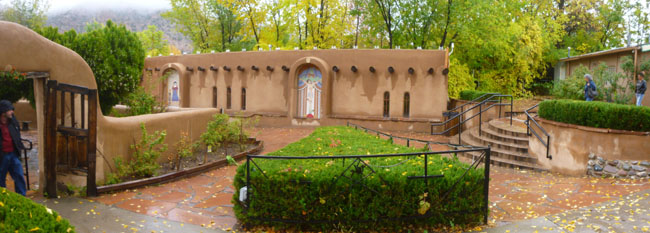 Outside the Sanctuary |
The most famous of all El Santuario de Chimayo pilgrimages is what is known as the Holy Pilgrimage. This beloved tradition takes place each year on Good Friday and tens of thousands of pilgrims participate. Some of these travelers walk for hundreds of miles! Pilgrims may even choose to walk barefoot or carry crosses to the El Santuario, which are then left on the grounds as a sign of respect.
People join the pilgrimage for a variety of different reasons. While some seek the healing powers of the holy dirt, others may choose to give thanks for answered prayers or ask God for divine intercession and enlightenment. Once the pilgrims each the Santuario de Chimayo, they enter a small, single-windowed room that is believed to be the original site of the miracle crucifix. There, they take a handful of holy dirt from the small hole that has stood there for nearly two centuries. They can rub it on their bodies, sprinkle it in their food, or even brew it with their tea. Then they are free to pray and celebrate on the church grounds.
|
|
There are other stories that swirl around the Chimayo Sanctuary. In one, based on folklore, on the night of Good Friday in 1810, a group of men from a secret brotherhood were conversing on a hill near the location of a once sacred spring to the Tewa Indians. One man saw a mysterious light shining in the distance, and after an investigation the men found there a strange half-buried crucifix. Taking the news to the nearest church in Santa Cruz, its priest had the wooden crucifix carried to the church. Before dawn the next morning, the crucifix had strangely disappeared, and it was later discovered at the original site where it had been found. The priest ordered for the crucifix to be brought back to the church two more times, but after each attempt it would once again reappear where it was originally found. People began to understand that the crucifix was meant to stay in that spot since it was believed to be sacred. Not long after, a Penitente brother by the name of Don Bernardo Abeyta built a small hermita (shelter) extension to his house so he could enshrine the miracle crucifix; this shelter is now a part of the El Santuario de Chimayo.
Speaking of the inside of the sanctuary, here are two pictures I took in the darkened chapel:
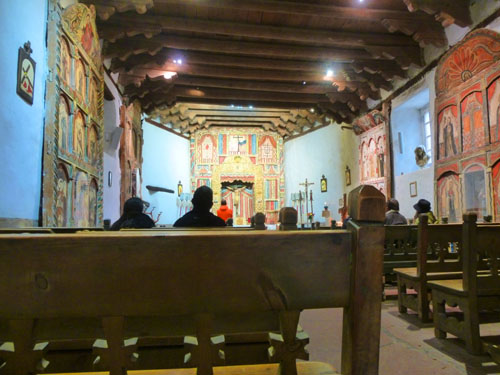 |
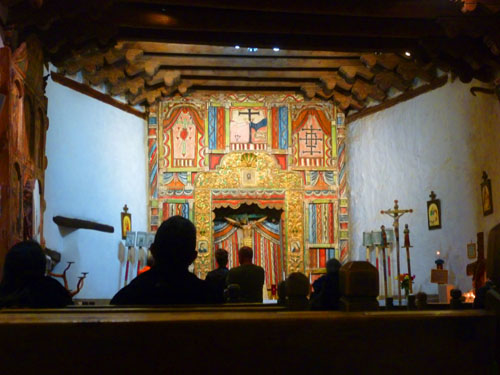 |
The Chimayo Museum and Weavery
We stopped in to the Trading Post again and Fred bought some of the famous Chimayo chiles before we left historic Chimayo to head back up the highway to visit the Chimayo Museum and the Ortega Weavery.
|
We parked near the museum and crossed over the Acequia de los Ortegas to the building that now houses the Chimayo Museum. The water flowing under this bridge is part of the Acequia de los Ortegas. This acequia or irrigation ditch dates back to the founding of Chimayo in the 1700s and begins in the canyon of the Rio Quemado behind what is now the Rancho de Chimayo. It is one of the oldest continuously used acequias in the state of New Mexico. In 1995 the Chimayo Cultural Preservation Association acquired a grant from the McCune Charitable Trust to help the members of the Acequia to pipe the ditch in thecanyon, where it was continuously clogged by mud slides, floods, and willows. Now the waters can flow freely in the historic acequia to the ancient fields of the Plaza del Cerro area of Chimayo.
The building we entered, which now houses the museum, is an ancestral home of the Ortega family, and is also important to the weaving tradition in Chimayo. Jose Ramon Ortega, born in 1828, and his wife Petra raised their children (all fourteen of them) in this house.
|
There were many interesting exhibits, and we spent quite some time here in the museum. I thought that the display of various musical instruments and small pianos was unusual, and one of the most unusual was this Bilhorn Telescope Organ; I had never seen anything quite like it. When you look at the picture, you will see that there is a descriptive note standing on top of it, and you might be interested in reading it. It's hard to read in the picture itself, but here is a link to enlarged picture of the descriptive note.
Neither Guy nor Fred took any pictures inside the museum, but I tried to record a number of the interesting items and photos on display. Here are some of the best of the pictures I took:
|
Jose was a fine weaver and taught the skill to many of his children, and one of them, Nicacio, started what is now called Ortega's Weaving Shop. Another child opened his own competing business next door, a third married Isidoro Trujillo and became a memberr of the Centinela weaving family. Two others also became noted weavers and passed the skill on to their own children. So after we left the museum we made a stop at the Ortega Weaving Shop. There we found a plethora of beautifully crafted items for sale. There was also a part of the shop you could go through where the actual weaving is done, although when we were there no one was at work on any of the looms:
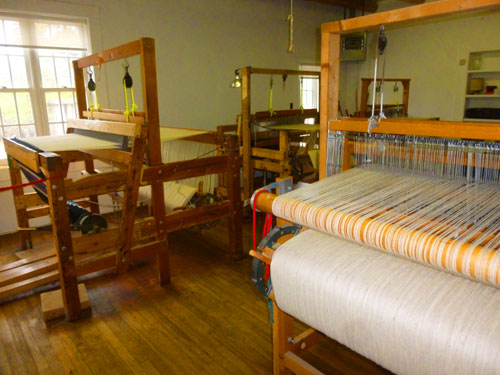 |
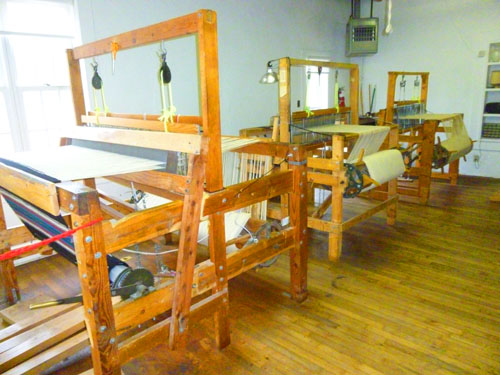 |
When we were finished at the weaving shop, we got back in the car and headed off through Espanola and up to the Ojo Caliente Hot Springs.
Ojo Caliente Hot Springs
Fred has been wanting to visit Ojo Caliente for years, but on the many trips we have made out to this area, there never seemed to be a good time to do so. But on this trip, we definitely planned to include them and so, even though the weather wasn't all that great, we headed up there to see what they were like.
|
The 40-mile ride up to Ojo Caliente took about an hour, as we were being cautious through the rain showers that were all around. While I was driving, Guy was taking more pictures of the Western Cottonwoods that were putting on their brilliant yellow show all along the roadside. Here are some of his pictures:
|
We reached Ojo Caliente about 3PM, and thought that we might first do a short hike before going into the hot springs.
The Tewa/Bosque River Trail
|
|
Our walk along the trail through the western cottonwoods (of course putting on their fall show of brilliant yellow leaves) took about a half hour. Just before we reached the large clearing where the Round Barn was located, Guy got a nice picture of Fred and I on the trail.
|
|
The barn was built by Anthony F. Joseph, the owner and manager of the Ojo Caliente Hot Springs. By the mid-1910s, the mineral resort had experienced much growth and increased popularity and the barn was needed to meet a growing need for dairy products at the mineral resort. The ability to provide dairy products signified a move towards commercial production from subsistence home production. By providing dairy products to guests, the resort was able to provide convenience and reassurance.
|
As you can see in many of our pictures of the barn (and even on the aerial view above), there were two antique vehicles parked in front of the barn, perhaps to signify how it might have looked when it was in use. In any event, the vehicles were interesting in and of themselves, and here are two good pictures of them:
|
|
Here at the barn, the Ojo Caliente River was easily accessible, so we walked down to it to take some pictures, passing some stone circles that someone had arranged in a clearing. Here are some of the pictures we took by the river:
|
This was a nice walk, and we were actually glad that we needed to take some time before visiting the hot springs, but now we were anxious to get back and see what they were like.
|
|
In addition to those pictures, Guy happened to take two individual pictures that stitched together nicely into a more panoramic view of the cottonwoods here in the Ojo Caliente River bottom, and if you will click on the thumbnail below, I'll show you that panoramic view:
|
Enjoying the Ojo Caliente Hot Springs
|
When we first came in, and before we went into the changing room to get into our bathing suits, we took a few pictures of the area where the individual pools, each with a different mineral concentration, are located:
|
Tradition tells us that often-warring tribesmen would set their weapons and differences aside to gather in peace at the springs to enjoy the benefits of the waters, and to trade and heal their wounds and ailments without conflict.
In the 1500s the Spaniards, in their quest for gold and the Fountain of Youth, also discovered the springs. One unknown explorer wrote in his journal:
| "The greatest treasure that I found these strange people to possess, are hot springs which burst out at the foot of a mountain. So powerful are the chemicals contained in this water that the inhabitants have a belief that they were given to them by their gods. These springs I have named Ojo Caliente." |
|
It was not until the 19th century that westward expansion caused Ojo Caliente to emerge from its prehistoric origins. In 1868, Antonio Joseph, New Mexico’s 1st Territorial Representative to Congress, built the first bathhouse and Ojo Caliente Mineral Springs became one of the first natural health resorts in the country. Ojo quickly became a hub of activity providing the mineral waters, overnight lodging, a Post Office, and a general store where historical ledgers show Kit Carson frequently purchased supplies. As a "sanitarium", Ojo was known throughout the country as a place where thousands of people were cured each year through the healing effects of the waters and the earth.
Three original buildings have been caringly restored and maintained and today are listed on the National Registry of Historic Places, including the Historic Bathhouse built in 1868 (you can see the bathhouse at center-right in the panoramic view below of how the area of the springs appears when you first enter through the hotel); the historic Ojo Caliente Hotel, built in 1917; and the Adobe Round Barn built in 1924.
|
The famous and the infamous have enjoyed these legendary waters and volumes of testimonials filled with declarations of miracle cures abound. The way the pools have been constructed ties them to Native American tradition- particularly insofar as the Kiva Pool is concerned. The Kiva Pool is the largest at Ojo Caliente, and the only one that is chlorinated (as it is the only one that kids are allowed to use). Pueblo Indians native to Northern New Mexico traditionally used Kivas as a gathering place for the performance of sacred rituals. Native American Kivas are circular areas dug into the ground, covered with vigas and accessible by ladders. Ojo's sacred waters are a perfect complement to this traditionally-inspired design. The Kiva Pool’s round shape and hand-carved stone walls echo the original Native American design:
|
Generations continue to make the pilgrimage to Ojo Caliente Mineral Springs to enjoy the unique combination of four different sulfur-free mineral waters: Lithia, Iron, Soda and Arsenic, with more than 100,000 gallons a day steaming to the surface revitalizing those who soak in them.
|
I carried my camera with me so I could take some pictures of the pools and of us luxuriating in them:
|
As you could see in many of our pictures, there were rows and rows of unused chaise lounges, and relatively few people in the pools. I am sure that this was due to the weather, and the fact that we were in the middle of the week. But even though the pools were busier earlier, today was nothing like some of the pictures I've seen were almost every chair is taken and there are ten or twenty people in every pool. All this made it a more personal experience, and we all three enjoyed it a great deal.
|
About twenty minutes later we were in the hotel restaurant ordering an early dinner. The restaurant is actually located in the building across from the hotel. We wanted to get finished eating while it was still light so we could hike at least partway along the Posi Trail to some Pueblo ruins.
Hiking the Posi Trail
|
|
We headed directly up into the hills, following the signs for the Posi Trail, and we had not walked more than twenty minutes or so (and ascended perhaps a hundred feet) before we turned and saw a rainbow behind us and directly over the resort. It was hard not to overdo the picture-taking, and we took quite a few. Here are three of the best of them:
|
|
|
Surrounding the springs are the ruins of the cities populated before the birth of history. Posi, "village at the place of the green bubbling hot springs" was the largest of 4 Pueblos surrounding the springs and home to thousands of people. Because of the work of archaeologists Adolph Bandelier and Edgar Hewitt, we know that Posi was a vibrant center of activity until the 15th century. The unusually diverse and abundant styles of pottery shards and other artifacts remain as a testament to Posi and the spring’s long-standing iconic significance within the larger region.
|
|
I want to include one last picture from our hike. Just before I rejoined Fred and Guy, I had my little camera take a panoramic shot of the hills and the resort down below, and I think that the picture turned out quite well:
|
Returning from the hike, we were losing our light pretty rapidly, so we brought our visit to Ojo Caliente to an end, piled into the car, and headed back to Paradise Pond. Tomorrow, the weather is supposed to be better, and we are looking forward to that, as we intend to visit Bandelier National Monument and Valle Grande.
 |
October 25, 2018: Bandelier National Monument and Valle Grande |
 |
October 23, 2018: Tent Rocks and Ghost Ranch |
 |
Return to the Index for Our Trip to New Mexico |